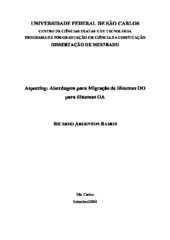Abordagem aspecting: migração de sistemas OO para sistemas OA
Abstract
An approach, named Aspecting, is proposed for eliciting aspects in Object Oriented
systems and subsequently re-factoring these systems as aspect oriented systems. The approach
has three phases: Understand the System Functionality, Treat the Interests and Compare the
Object Oriented System with the Aspect Oriented System. Each phase is presented with the
details to be observed by the software engineer for the migration of the systems to be made
safely and to obtain a quality product. Techniques of separation of concerns and aspect
oriented programming are used in three prospective study cases, in order to induce
formulating the approach. Guidelines are established to model the concerns identified, using
class diagrams in UML notation. Other guidelines govern the implementation of concerns as
aspects, using the Aspect J language. The use of regression tests in the system after the system
code reorganization now implemented with aspects, for checking if the original functionality
has been preserved in the migration, completes the approach. A fourth study case, for
illustrating the approach application, is also presented.
